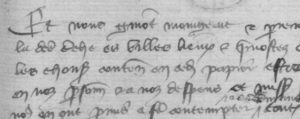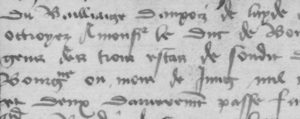Here’s the latest on the Savoy palaeography post from a couple of days back: firstly, I donned my image analysis hat and went hunting for any sign of the missing “l”-loop. Enhancing f116v right to the edge, you can certainly just about make out a loop above the “t” of “michiton” (highlighted below), which would be consistent with the prediction that this word was originally “nichil”:-
Of course, I’d be the first to admit that what’s being enhanced here is probably not ink but rather a faint depression in the vellum, which may or may not be connected with the word. Hence, given that this is right at (or possibly beyond) the limit of what we can see in the Beinecke’s scans, it’s important not to get too excited – the right thing to do would be to wait until we can get a different kind of close-up scan of these details, so we can make proper concrete progress.
But in the continued absence of useful data that would settle this kind of question definitively (when will the Beinecke’s Kevin Repp respond to my requests?), here’s the wrong thing, i.e. yet more probabilistic speculation based on uncertain codicological evidence. 🙂
If this is “nichil” (or indeed “michi“), I think we can tentatively infer quite a lot. For a start, it would imply that this line of the text is
- probably written in Latin, specifically in what is known as “Ecclesiastical Latin”;
- probably after 1400 (which is roughly when Leonardo Bruni started advocating the use of “michi” and “nichil“);
- probably in Northern Italy or Southern France (which is where Bruni’s ideas spread the strongest); and
- probably in either an ecclesiastical or proto-humanist context (the two groups most influenced by Bruni).
Yet I would say that the handwriting seems less an Italian hand than a Southern French hand: and to back this up, I’ve been going through handwritten documents from 1350-1500 in the Archives Départementales de la Côte d’Or, in particular the “Recherches des feux des bailliages” (which I presume come from a hearth-counting tax assessment programme of the time). The records for Auxois contain documents from 1376-78, 1397, 1413, 1460, 1461, 1470 etc, so provides quite a nice vertical palaeographic slice of the archives:-
Auxois 1376-78: fol.2 – “Ce sont les noms et surnoms…“
Voynich researchers should immediately feel very much at home here: there’s the Gothic-y angular “l”, the “y”-like “p” (though closed rather than open), and “premiere” on the bottom line is even written with a generously overlooped “p” (as per the VMs’ Q1 quire number).
Auxois 1397: fol.221
Curiously, the 1397 record doesn’t seem to be as good a match to the VMs’ marginalia as the 1376-78 record…
Auxois 1413: fol.2
…while the 1413 hand is I’d say an even worse match (and don’t even ask about the 1460 hand, that’s worse still).
So, the best matches to the handwriting in the VMs’ marginalia would seem to be from Savoy circa 1340-1380 (the previous post showed “nichil” written in a 1345 Savoy hand). Now, this kind of evidence isn’t quite enough to date the VMs on its own: but if we link it with the radiocarbon dating and unusual quire numbering, we might perhaps tentatively infer overall that circa 1425, this line of the marginalia was added (probably in Savoy) by an old monk (or possibly a humanist) who was probably from Savoy. All of which may not sound like much, but it might well yield a genuinely concrete step in the right general direction, let’s hope.
I’d be interested to find out what Voynich palaeographers make of this (*cough* Barbara): and if it is basically right, then perhaps Voynich researchers might now do well to start (1) finding archives containing Savoy letters and documents written circa 1400-1430, and (2) book resources on Savoy social networks circa 1400-1450. Who knows, perhaps we will find a letter by an old Savoyard monk or humanist with surprisingly similar handwriting, who knows? 🙂




Pingback: Tweets that mention Voynich f116v “nichil” update… | Cipher Mysteries -- Topsy.com
Many, many years ago, a Latinist on the Voynich mailing list wrote that ‘michi’ would have been a completely acceptable way for writing ‘mihi’ during some period of time. I wonder if it was Mark Sullivan (a.k.a. Sulla).
I have to admit that the images of the French writing above do not seem very similar to the f116v writing to me, but of course they are in an elegant bookish hand. What can we do, there seems to be a preference for showing images of such more elegant MSs on the web, rather than for medieval or early modern notes written cursorily.
The ‘ch’ in ‘michiton’ (as this word is still affectionally referred to) appears to me as german, and I would not be surprised if this could be confined to a particular region. This fits very well with the observation that the scribe of the MS was probably a German speaker, and there are German words on the bottom line of this same short pieces of text.
Hi Nick! The mention of Savoy reminds me of the Franco-Provençal or Arpitan language. There is indeed an Arpitan Wikipedia. We’re talking about paleography, but who knows?
Dennis: it certainly could be Arpitan, but right now I’m more interested in the ‘michitonese’ palaeography (and the codicology of what happened to it to make it unreadable) – figuring out what language each part of it is in (oh, and what it says) should probably come afterwards. 🙂
Pingback: fol 67v-i ~ chronological strata « voynichimagery
Hello all,
here is the solution of the two Voynichese words on f116v that are normally ignored so gladly:
EVA (oror sheey)
–> onon whuy
–> أنٌ وهي
–> “that is”
Joachim.
Joachim,
As someone who has followed your explanations, and also read the criticisms of it – especially Helmut’s, which seem to me informed by long and serious study of Arabic – I think I’d be more persuaded if you found some well-known scholar to check and verify your interpretation of the text. Arabic isn’t a rare language, so it shouldn’t be difficult to find two or three academics able and willing to consider the text.
It must be disheartening to feel you’ve broken the cipher, but to have your work largely ignored – so I thought I’d suggest getting an independent opinion or two.
I don’t expect that they’d need to check the whole thing – just two or three pages should be enough.
All the best.
Diane
Diane
It’s nice to see that you are interested in the decoding of the language, in this case at least, even though you’ve always taken the position to want to have nothing to do with that stuff.
Fact is that I’m working (only) since 18 month on that project, now together with a multilingual native Arab educated in Beyrut, and other people e.g. for proofreading.
We just deal with the creation of a dictionary Voynichese-English, until now containing unique 5000 lexemes (meaningful words and phrases).
This has become possible only after I had created a software to isolate the language elements from the VMs (btw. there is no other way to get such information at all !).
It will still take a while until I’m able finally to publish the complete solution (including some pages).
Meanwhile, you need to stand the presentation of some relevant minor snippets here and there.
The criticism concerning Helmut, to whom you impute long and serious study of Arabic (I have other information about): It is several month back, was also a problem of representation of Arabic script, since then much has changed, the folio translations in my blog are now outdated in detail.
No, i’m not disheartening about my work to be largely ignored.
I only like to smile about it. It is a psychological problem for the people. They love to discuss UFO-like theories extensively.
But when a concrete solution is about to threaten, they would prefer their own instead. Their own or none.
You did follow to my explanations?
I don’t think so. I just published some well-founded facts about the origin of the VM from Al Andalus.
Although it should fall into your fields of knowledge, I do not see any response, which is a pity.
All the best,
Joachim.
A long delay, but hopefully a valid ‘translation’ for the so-called michiton oladaba or nichil discussions for B-408, f-116v: I mentioned several months ago that Busbecq was signing off on the ‘scrappiest’, last folio page, in latin phraseology: ” Ancyranum Augustus”. He returned to Europe with some 240 manuscripts, which were to be delivered to Vienna. The Austrian emperor promptly directed Busbecq, manuscripts, and zoo to Rudolph II in Prague/Bohemia.
Much of Rudolph’s possessions, manuscripts and paintings in particular, ended up in Papal archives, but some can still be observed in the castle/museum: Kastel Karlstein (NOT Hradczany).
bdid1dr
Or maybe a monk living on the very border of the Duchy of Savoy and the Duchy of Milan, who knows, indeed??
(Note, Vercelli was given to the Duchy of Savoy in 1427 by the Duchy of Milan.)